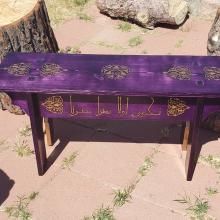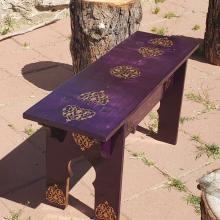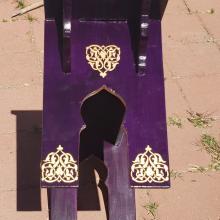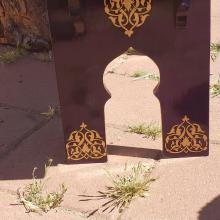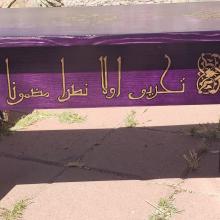This bench is based on several extant examples that primarily date between the 14th and 16th Centuries (several examples are pictured at <https://thomasguild.blogspot.com/2018/03/medieval-benches.html>. THis bench style seems to have been common given it's appearance in many Illuminated manuscripts and even tapestries, such as the famous Cluny Unicorn and Maiden Tapesties, which date from the 16th Century. Most extant examples that I've observed were made of oak and were generally decorated by wood carving and sealed with bees wax rather than being painted.
This bench is based on the work of Master Dafydd Ap Gwysti (David Kuijt). His original article can be found at <https://www.greydragon.org/library/gothicbench.html>. I took his interpretation of these benches and modified it to make it easier to break down flat for travel, as the purpose of these benches was to provide a more period looking seating option to make my encampment have a greater medieval feel. Master Dafydd's design did not break down flat and it used modern fasteners in it's construction (hidden screws).
As mentioned above, almost all of the extant examples that I have observed were made from oak with the exception of one that was made from fruit wood, most likely cherry or pear. I chose pine wood to build my example due to factors of material availability, cost and the fact that I wanted to decorated it in my heraldic colors and paint it with Islamic designs to fit more closely with my persona.
In terms of construction, I used modern tools, both power and hand, in order to make a number of benches (In this case I have built or am finishing five different benches). These were also built as part of a class within my Barony as a way of encouraging local members to eshew modern camp chairs in favor of more period seating. An additional nine benches were built by members of the Baronial populace beyond my five.
I will say that no modern fasteners were used to build these benches. All of them slide together with slots and pegs, in keeping with period construction practices. This has also made it easier to make them able to break down flat and fit into the carrying bags that have been made for them.
Dieric Bouts. Triptych The last supper, dated 1464-1468. Oil on oak panels. Museum M, Leuven, Belgium.
15th Century French or Flemmish Stool (https://www.metmuseum.org/art/collection/search/70011826?rpp=20&pg=2&ft=*&when=A.D.+1400-1600&where=Europe&what=Woodwork&pos=31)
A boarded stool, Elizabethan, oak, of trestle form, with moulded seat and shaped side rails (http://www.sothebys.com/en/auctions/ecatalogue/2007/the-oak-and-country-sale-w07803/lot.65.html)
Bench. Artist/maker unknown, Flemish. Made in Southern Netherlands (modern Belgium). 15th century. Oak (https://www.philamuseum.org/collections/permanent/44315.html?mulR=1980977384%7C214)
14th Century Stool, Musee de Cluny
THE LADY AND THE UNICORN Paris (models), circa 1500 ; wool and silk ; Cl. 10831-10836, Musee de Cluny

